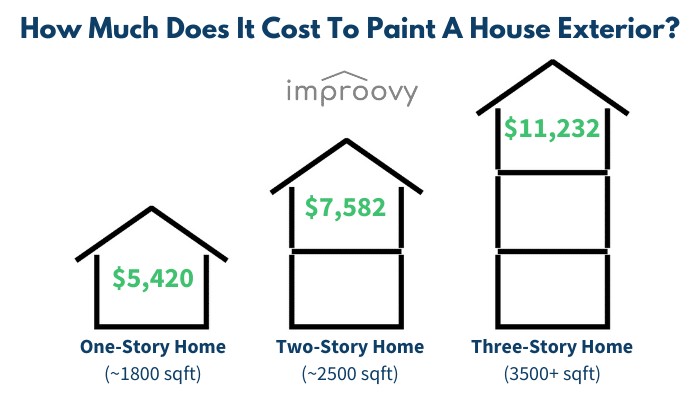Painting your house exterior is a significant investment that boosts curb appeal and protects your home from the elements. Understanding how much paint you’ll need is crucial for budgeting and project planning. This guide breaks down the factors influencing paint quantity and provides practical tips to ensure you purchase the right amount.
Determining Paint Needs: Key Factors
Several factors influence how much paint you’ll need for your exterior project. Accurately assessing these will help you avoid underbuying or overbuying.
1. Square Footage of the Exterior Surface
The most direct way to estimate paint needs is by calculating the total surface area you’ll be painting. This includes siding, trim, and any other exterior features. For an average 2,500-square-foot home, the exterior painting surface area can be roughly the same, but this can vary.
To refine your estimate, account for attached structures like sunrooms or garages. For challenging areas such as dormers on two-story homes or surfaces with peeling paint, add an extra 10% to 50% to your square footage calculation. These areas require more time, labor, and often, more paint.
2. Number of Coats
For any exterior painting project, applying at least two coats is highly recommended, especially when changing colors. Multiple coats ensure proper coverage, durability, and a professional finish. If you’re making a drastic color change, factor in an extra 50% to 75% of paint to account for the added coverage needed.
3. Porosity and Texture of the Surface
The surface you’re painting significantly impacts paint absorption. Porous surfaces like bare brick or stucco will soak up more paint than smoother surfaces like vinyl siding. When painting porous materials, consider using a primer specifically designed for the surface to seal it and reduce the amount of paint needed for subsequent coats.
4. Paint Coverage per Gallon
Check the paint can for the manufacturer’s estimated coverage area per gallon. Typically, a gallon of exterior paint covers 300-400 square feet with one coat. Keep in mind that this is just an estimate, and actual coverage may vary depending on the factors mentioned above.
5. Trim and Accent Areas
Don’t forget to factor in paint for trim, soffits, windows, fascia, and gutters. A general rule of thumb is that one gallon of paint will cover exterior trim for every eight gallons of body paint needed. For color changes on trim, double that amount to account for a second coat.
Calculating the Amount of Paint Needed
Here’s a step-by-step guide to calculating the amount of paint you’ll need:
- Calculate the total surface area: Measure the height and width of each wall, then multiply to get the square footage. Add the square footage of all walls together.
- Account for trim and other features: Estimate the surface area of trim, doors, and windows. A rough estimate is to calculate the perimeter and multiply by width.
- Determine number of coats: Decide if you need one or two coats (recommended).
- Calculate paint volume: Divide the total square footage by the paint coverage per gallon (check the paint can) and multiply by the number of coats.
Example:
- House size: 2,500 sq ft (assume same for exterior surface)
- Number of coats: 2
- Paint coverage: 350 sq ft per gallon
(2500 sq ft x 2 coats) / 350 sq ft per gallon = 14.3 gallons
Therefore, you’ll need approximately 14-15 gallons of paint.
Don’t forget to add paint for trim and other accent areas based on the rule of thumb mentioned earlier.
DIY vs. Professional Painting
Painting your house exterior yourself can save money, but it’s a time-consuming and physically demanding task. Professional painters have the experience, equipment, and expertise to complete the job efficiently and safely.
The average exterior painting labor cost is $54-$91 per hour. Painting a two-story home professionally typically ranges from $5,844 to $9,321 for labor and materials. The cost to paint the exterior of a house yourself can range between $500 and $2,400 total for supplies and paint.
Consider the value of your time and energy when deciding whether to DIY or hire a professional. Also, factor in the cost of renting equipment like ladders and power washers.
Tips for Saving Money on Exterior Painting
- Choose the right time: Professional painting and drywall repair prices are often lowest during specific months.
- Prepare the surface: Power wash, scrape loose paint, and repair any damage before painting.
- Get multiple quotes: Compare prices from different painting contractors.
- Choose colors wisely: Drastic color changes require more coats of paint, increasing the cost. Sticking with a similar color scheme can save you money.
- Consider DIY for smaller projects: Painting the front door, porch, or deck can be a cost-effective DIY project.
Conclusion
Estimating How Much Paint To Paint A House Exterior requires careful consideration of several factors, including square footage, surface type, number of coats, and trim areas. By accurately assessing these factors and using the calculation methods provided, you can minimize waste and ensure you have enough paint to complete your project successfully. Whether you choose to DIY or hire a professional, proper planning and budgeting are key to achieving a beautiful and long-lasting exterior paint job.
